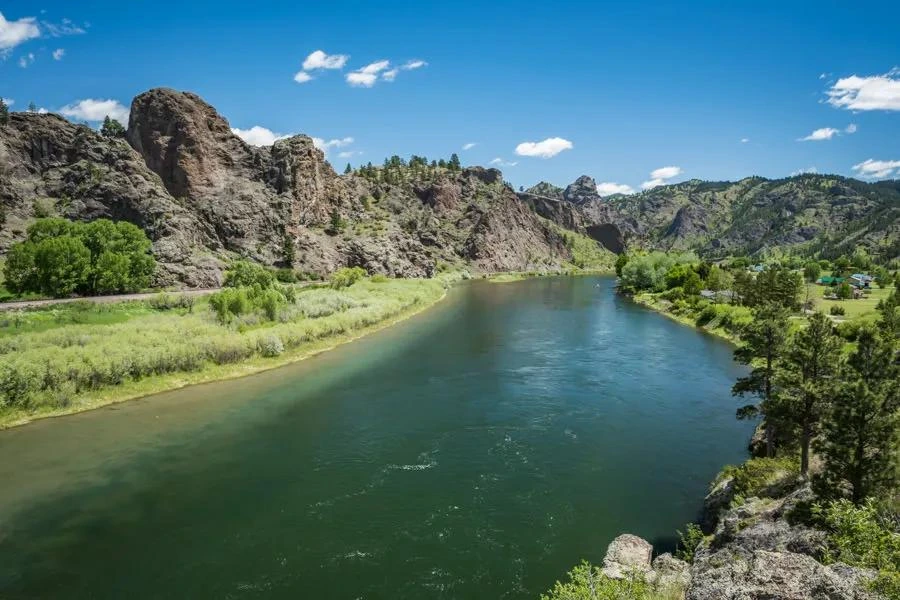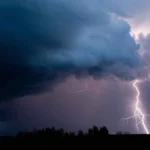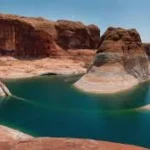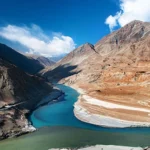
Welcome to our exploration of the Missouri River, one of the longest rivers in North America and a vital waterway with a rich history and diverse ecosystem. In this blog post, we’ll uncover 25 fascinating facts about this majestic river that flows through the heart of the United States. From its geological significance and historical milestones to its role in local culture and wildlife, the Missouri River is a source of intrigue and inspiration. Whether you’re a history buff, an outdoor enthusiast, or simply curious about the natural world, you’re sure to discover something new and engaging about this iconic river. Let’s dive in!
The longest river in North America is the Missouri River. Stretching approximately 2,341 miles, the Missouri River is recognized as the longest river in North America. It originates in the Rocky Mountains of Montana and flows eastward before joining the Mississippi River near St. Louis, Missouri. This extensive length makes it a vital waterway for various ecosystems and human activities, contributing significantly to the geography and hydrology of the United States.
Part of the Missouri River Basin, the Missouri River Forms. The Missouri River is a key component of the Missouri River Basin, which encompasses over 500,000 square miles across several states, including Montana, North Dakota, South Dakota, Nebraska, Kansas, Iowa, and Missouri. This basin plays a crucial role in managing water resources, supporting agriculture, and maintaining diverse habitats for wildlife. The river’s tributaries and surrounding landscapes contribute to its vast drainage area, influencing local climates and ecosystems.
It was a major route for explorers during the 1800s. During the 1800s, the Missouri River served as a critical transportation route for explorers, traders, and settlers venturing westward. Notably, the Lewis and Clark Expedition utilized the river to navigate the uncharted territories of the American West. The river facilitated trade and communication between different regions, significantly shaping the economic and cultural landscape of the United States during this period of expansion.
Named After the Indigenous Missouri Tribe, the Missouri River Was. The Missouri River derives its name from the Missouri Tribe, a Native American group that historically inhabited the region. The tribe’s name is believed to mean “people of the big canoes,” reflecting their connection to the river and its significance in their way of life. This naming highlights the river’s cultural importance and the deep-rooted ties between indigenous peoples and the natural environment.
A Wide Range of Wildlife Exists in the Missouri River. The Missouri River is home to a diverse array of wildlife, including fish, birds, mammals, and reptiles. Species such as catfish, paddlefish, and various types of bass thrive in its waters. The river’s banks and surrounding habitats provide nesting and feeding grounds for numerous bird species, making it an essential area for biodiversity. This rich ecosystem supports both recreational fishing and wildlife observation, contributing to the region’s ecological health.
It drains a vast part of the United States. The Missouri River drains a significant portion of the United States, covering parts of ten states and contributing to the Mississippi River system. Its extensive drainage basin collects water from rain and snowmelt across a vast area, playing a crucial role in managing water resources for agriculture, industry, and communities. The river’s flow patterns, and seasonal variations also impact local hydrology and flood management efforts.
The river has been modified by dams and reservoirs. Over the years, the Missouri River has been extensively modified through the construction of dams and reservoirs. These modifications were primarily implemented for flood control, navigation, and hydroelectric power generation. Major dams, such as the Fort Peck Dam in Montana and the Gavins Point Dam in South Dakota, have transformed the river’s flow and created reservoirs that serve various purposes, including irrigation and recreation.
Home to Wildlife Like Bald Eagles, Beavers, and River Otters, the Missouri River is. The Missouri River provides critical habitat for a variety of wildlife, including iconic species such as bald eagles, beavers, and river otters. Bald eagles can often be seen soaring above the river, especially during the winter months when they migrate to the area for food. Beavers play a vital role in shaping the river’s ecosystem by building dams that create wetlands, while river otters thrive in the aquatic environment, contributing to the biodiversity of the area.
The river has been modified by dams and reservoirs. As mentioned earlier, the Missouri River has undergone significant alterations due to the construction of numerous dams and reservoirs. These structures have been pivotal in managing water flow, mitigating flooding risks, and providing water for agricultural irrigation. However, these modifications have also impacted the river’s natural habitats and the species that depend on them, leading to ongoing discussions about balancing human needs with ecological preservation.
It is used for navigation. The Missouri River has historically served as an important navigation route for transporting goods and people. Its navigable waters allow for commercial shipping and recreational boating, making it a vital artery for trade and travel in the region. The river’s navigation system has been enhanced by locks and dams that facilitate the movement of vessels, contributing to the local economy and supporting industries reliant on water transport.
It is the lifeblood of local economies. The Missouri River plays a crucial role in supporting the economies of the communities along its banks. It provides essential resources for agriculture, such as irrigation for crops and livestock, which are vital to the local agricultural economy. Additionally, the river supports industries such as fishing, tourism, and recreation, drawing visitors for activities like boating, camping, and wildlife watching. The economic benefits derived from the Missouri River extend beyond direct uses, as it also enhances property values and contributes to the overall quality of life for residents in the region.
Dams of the Missouri River Include Fort Peck, Montana and Gavin’s Point, South Dakota. The Missouri River is home to several major dams, with Fort Peck Dam in Montana and Gavins Point Dam in South Dakota being two of the most significant. Fort Peck Dam, completed in 1940, is one of the largest earth-filled dams in the United States and creates Fort Peck Lake, a popular recreational area. Gavins Point Dam, completed in 1957, is part of the Missouri River Mainstem Reservoir System and plays a critical role in flood control and water management for the river system.
The river has historical significance. The Missouri River is steeped in historical significance, serving as a key route for exploration, trade, and settlement in the United States. It has been the site of numerous historical events, including the Lewis and Clark Expedition, which aimed to map the newly acquired western territories. The river’s banks have witnessed the interactions between Indigenous peoples and European settlers, shaping the cultural and historical narrative of the region.
A Site for Civil War Battles, the Missouri River Was. The Missouri River’s strategic location made it a significant site during the Civil War, with several battles occurring along its banks. Control of the river was crucial for the transportation of troops and supplies, leading to conflicts between Union and Confederate forces. Notable battles, such as the Battle of Boonville and the Battle of Westport, highlight the river’s importance in military strategy during this tumultuous period in American history.
It has a significant impact on local weather patterns. The Missouri River influences local weather patterns through its effects on humidity and temperature. The large body of water can moderate temperatures in adjacent areas, creating milder conditions. Additionally, the river contributes to local precipitation patterns, as moisture evaporating from its surface can lead to increased rainfall in nearby regions. This interplay between the river and the atmosphere underscores the river’s role in the broader climate system.
Crucial for Transporting Agricultural Goods, the Missouri River Is. The Missouri River serves as a vital transportation route for agricultural goods, facilitating the movement of crops such as corn, soybeans, and wheat from the Midwest to markets across the country and beyond. Barges and other vessels navigate the river’s waters, providing an efficient means of transport that reduces transportation costs for farmers and contributes to the agricultural economy. This transportation network is essential for ensuring food supply chains remain robust and effective.
The river’s history is recorded in old maps and journals. The historical significance of the Missouri River is well-documented in old maps and journals from explorers, settlers, and Indigenous peoples. These records provide valuable insights into the river’s geography, ecology, and the interactions of various cultures with the landscape. They serve as a testament to the river’s role in shaping the history of the American West and offer a glimpse into the past, enriching our understanding of the region’s development.
The Missouri River shelters endangered species like the Piping Plover and Pallid Sturgeon. The Missouri River is home to several endangered species, including the Piping Plover, a small shorebird that relies on sandy riverbanks for nesting, and the Pallid Sturgeon, a prehistoric fish species that requires clean, free-flowing waters to thrive. Conservation efforts are ongoing to protect these species and their habitats, highlighting the river’s ecological importance and the need for sustainable management practices to ensure their survival.
A Key Flyway for Migratory Birds, the Missouri River Is. The Missouri River serves as a critical flyway for migratory birds, providing essential stopover sites during their long journeys. The river’s diverse habitats, including wetlands and riparian zones, offer food and shelter for various bird species. This makes the river an important area for birdwatching and conservation efforts, as it supports a rich diversity of avian life and contributes to the overall health of the ecosystem.
The Diverse Landscape of the Missouri River Includes Forests, Grasslands, and Wetlands. The Missouri River flows through a diverse landscape that encompasses forests, grasslands, and wetlands. These varied ecosystems support a wide range of plant and animal species, contributing to the river’s ecological richness. The forests along the riverbanks provide habitat for mammals and birds, while the grasslands and wetlands play a crucial role in water filtration and flood management. This diversity underscores the importance of preserving these natural areas for future generations.
Important Transportation Route for Early European Colonizers, the Missouri River Was. The Missouri River served as a critical transportation route for early European colonizers, facilitating their exploration and settlement of the American West. In the 18th and 19th centuries, the river became a vital artery for fur traders, missionaries, and settlers moving westward in search of new opportunities. The river’s navigable waters allowed for the transport of goods and people, significantly impacting the expansion of the United States and the establishment of new communities along its banks.
A Symbol of American Heritage, the Missouri River Is. The Missouri River stands as a symbol of American heritage, representing the nation’s exploration, growth, and connection to the natural environment. Its historical significance is reflected in the stories of Indigenous peoples, early explorers, and settlers who relied on the river for sustenance and transportation. The river has inspired countless cultural expressions, from literature to art, and continues to be celebrated as a vital part of America’s identity and history.
In 1978, Alan Captain America Jones swam 112 miles of the Missouri River handcuffed. In a remarkable feat of endurance and determination, Alan “Captain America” Jones swam 112 miles of the Missouri River in 1978 while handcuffed. This extraordinary event showcased not only his physical prowess but also drew attention to the river and its significance. Such unique challenges highlight the river’s role as a setting for adventure and personal achievement, further embedding it in the cultural narrative of the region.
FAQs about the Missouri River:
1. What is the Missouri River’s length?
The Missouri River is approximately 2,341 miles long, making it the longest river in North America. It flows from its source in the Rocky Mountains of Montana to its confluence with the Mississippi River near St. Louis, Missouri.
2. What states does the Missouri River flow through?
The Missouri River flows through several states including Montana, North Dakota, South Dakota, Nebraska, Iowa, Kansas, and Missouri. It plays a crucial role in the geography and economy of these states.
3. What is the historical significance of the Missouri River?
The Missouri River has significant historical importance, serving as a major transportation route for Native American tribes and later European explorers and settlers. It was also a key part of the Lewis and Clark Expedition in the early 1800s, which explored the western territories of the United States.
4. What are some major cities along the Missouri River?
Several major cities are located along the Missouri River, including Kansas City, Missouri; Omaha, Nebraska; and St. Louis, Missouri. These cities have developed around the river and have utilized it for trade, transportation, and recreation.
5. What wildlife can be found in and around the Missouri River?
The Missouri River is home to a diverse array of wildlife. Common species include various fish (like catfish and bass), birds (such as herons and eagles), and mammals (including beavers and deer). The river’s ecosystem supports both aquatic and terrestrial wildlife.
6. Are there recreational activities available on the Missouri River?
Yes, the Missouri River offers numerous recreational activities, including fishing, boating, kayaking, and hiking along its banks. Many parks and recreational areas provide access to the river for outdoor enthusiasts.
7. What are the major tributaries of the Missouri River?
Some of the major tributaries of the Missouri River include the Yellowstone River, Platte River, and Kansas River. These tributaries contribute to the river’s flow and ecosystem.
8. How does the Missouri River impact agriculture?
The Missouri River is vital for agriculture in the surrounding regions, providing irrigation and transportation for agricultural products. Its waters support farming activities, particularly in the fertile plains of Missouri and Nebraska.
9. What are the environmental concerns related to the Missouri River?
Environmental concerns regarding the Missouri River include pollution, habitat loss, and the impact of damming and water management practices. These issues can affect water quality, wildlife habitats, and the overall health of the river ecosystem.
10. Are there any notable landmarks or parks along the Missouri River?
Yes, there are several notable landmarks and parks along the Missouri River, including the Lewis and Clark National Historic Trail, the Missouri River State Park, and various wildlife refuges. These sites often provide educational opportunities and recreational activities for visitors.








